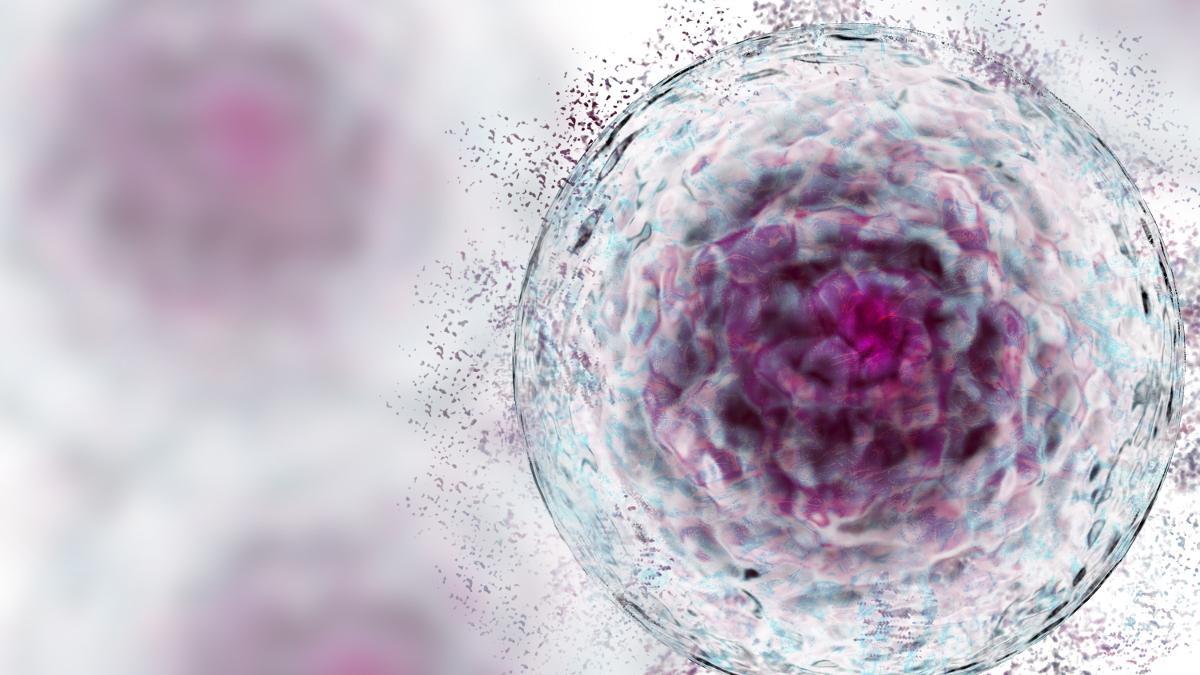What is a senescent cell?
A senescent cell is one whose life cycle has come to a permanent end. In the normal scheme of things, such cells are eliminated from the body by the immune system. But in some cases, this fails to happen and they accumulate in tissues, with potentially serious consequences for health.

The causes of senescence
The process of replicative senescence is naturally initiated in cells as they age. It is triggered by the shortening of telomeres, the DNA sequences found at the tips of chromosomes, which become shorter with each successive DNA replication. After a certain point, this replication of DNA ceases, and the cell stops dividing before dying a natural death. Scientists have recently shown that stress leads to an acceleration in cellular aging by intensifying this telomere-shortening. (1)
There are also external triggers of senescence such as oxidative stress. In a similar way to radiation or UV, oxidative stress damages DNA. Sometimes the cell is able to repair the DNA and ‘restart the machine’, but in other cases, the cell enters senescence in order to be destroyed.
Finally, senescence can be induced by hyperactivation of genes which usually encourage proliferation of cells and therefore cancer. When faced with such hyperactivation, cells respond by entering senescence.
What happens to the senescent cell?
The senescent cell becomes enlarged and flatter, structural changes occur in its chromatin (the ‘framework’ in which DNA is contained), it becomes unreceptive to cell growth and suicide factors … In short, it ensures a permanent end to its activity and multiplication. In addition, the senescent cell secretes pro-inflammatory molecules which summon the immune system responsible for eliminating and destroying dead cells. In this way, senescence and its immune-activating entourage often contribute to inhibiting the development of tumors.
However, in what is a particularly complex molecular process, it can happen that senescence promotes tumor proliferation in the cell’s surrounding environment. The inflammatory molecules secreted by senescent cells may encourage neighbouring cells to convert into pre-cancerous cells and then foster their proliferation. (2)
Note
Research has recently identified the proliferative capacity of senescent cells during embryo development. (3)
The pathological consequences of senescence
Senescence is one of the body’s natural mechanisms of aging and its characteristic markers such as wrinkles or skin slackening. But it is also a cause of certain diseases, as we’ve seen with cancer. The immune system’s failure to destroy senescent cells leads to excessive inflammation and the development of metabolic inflammatory conditions such as obesity and type 2 diabetes.
Senescence is also implicated in arthritis, osteoporosis and atherosclerosis (stiffening of the arteries), as well as in neurodegenerative diseases such as Parkinson’s or Alzheimer’s. (4)
Senolytics, a hopeful option for life expectancy
To maintain good health for as long as possible, the most important recommendation is still to adopt a sensible lifestyle. But particularly promising molecules called senolytics might also play a positive role in the future. (5) An emerging area of anti-aging research for some years now, these compounds could work against senescence and thus slow down the aging process.
Offering potential for preventing the above-mentioned diseases, these senolytics include molecules already present in nature, the most promising of which have been identified as:
- fisetin, a flavonoid naturally present in acacia, strawberries and mangos, for example;
- and quercetin, another flavonoid found in capers, chilis, red onions and elderberries …
They are also available in supplement form (such as Fisetin and Senolytic Complex): an invaluable aid to slowing down the aging process!
References
- Herranz, N. & Gil, J. Mechanisms and functions of cellular senescence. J. Clin. Invest. 128, 1238–1246 (2018).
- Campisi, J. & d’Adda di Fagagna, F. Cellular senescence: when bad things happen to good cells. Nat. Rev. Mol. Cell Biol. 8, 729–740 (2007).
- Storer, M. et al. Senescence Is a Developmental Mechanism that Contributes to Embryonic Growth and Patterning. Cell 155, 1119–1130 (2013).
- Muñoz-Espín, D. & Serrano, M. Cellular senescence: from physiology to pathology. Nat. Rev. Mol. Cell Biol. 15, 482–496 (2014).
- Kirkland, J.L., Tchkonia, T., Zhu, Y., Niedernhofer, L.J. and Robbins, P.D. (2017), The Clinical Potential of Senolytic Drugs. J Am Geriatr Soc, 65: 2297-2301.
Keywords
12 Days
A Product worth waiting for when not…
A Product worth waiting for when not available and then arriving as a surprise!
DOMINIC
14 Days
On time shipping
On time shipping
GEORGE Verne
15 Days
Ordering was easy and the product was…
Ordering was easy and the product was delivered with no problems. Appreciated that I was notified when it would arrive. Thanks!
MascarC
21 Days
Great customer service - responsive …
I ordered from them and my item was unavailable for sometime. I was super happy when they reactivated my order and shipped my item which arrived very quickly. Great customer service.
Ruth Rueter
22 Days
Super fast shipping
Super fast shipping
Donald Borling
25 Days
Reputable companysearch and the number of…
The research and the number of selection of products.
NAKHJAVAN Shervin
38 Days
The Anti Aromatase is a great product
The Anti Aromatase is a great product. You just need to have constant inventory. Recently this product has been out of stock.
GEORGE Verne
40 Days
Great help on chat
Great help on chat. Knowledgeable and friendly.
Jason Argos
43 Days
Customer service was fast and friendly.
Customer service helped to stop the transaction process of the subscription. I appreciated that.
Greenie
43 Days
I order here due to the high quality of…
I order here due to the high quality of the products and the quick delivery of items - thank you
Barbara J
45 Days
SuperSmart's Eye Pressure supplements: highly recommended!
I purchase SuperSmart's Eye Pressure supplements regularly for over 5 years, and gotta say they are truly a wonderful product for my Glaucoma. Highly recommended if you have eye pain from your Glaucoma.
D. Martinez
49 Days
Quick service
Quick service
MONELL
50 Days
Speedy service.
Speedy service.
ROSENTHAL Marvin
54 Days
Clear website- Efficient
Clear website. Excellent search engine and fast delivery!
Mohamad Hussein
56 Days
They have great products.
They have great products.
Vickie



